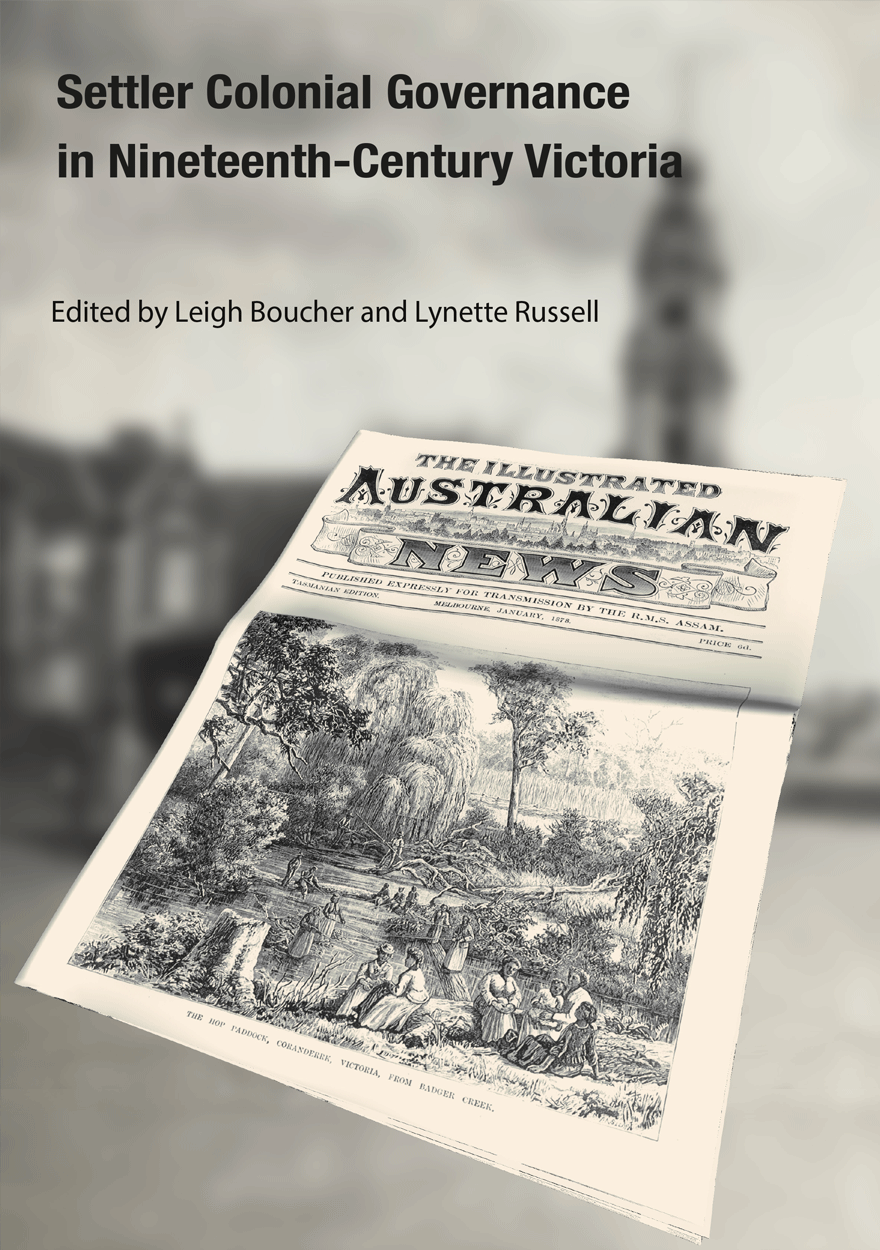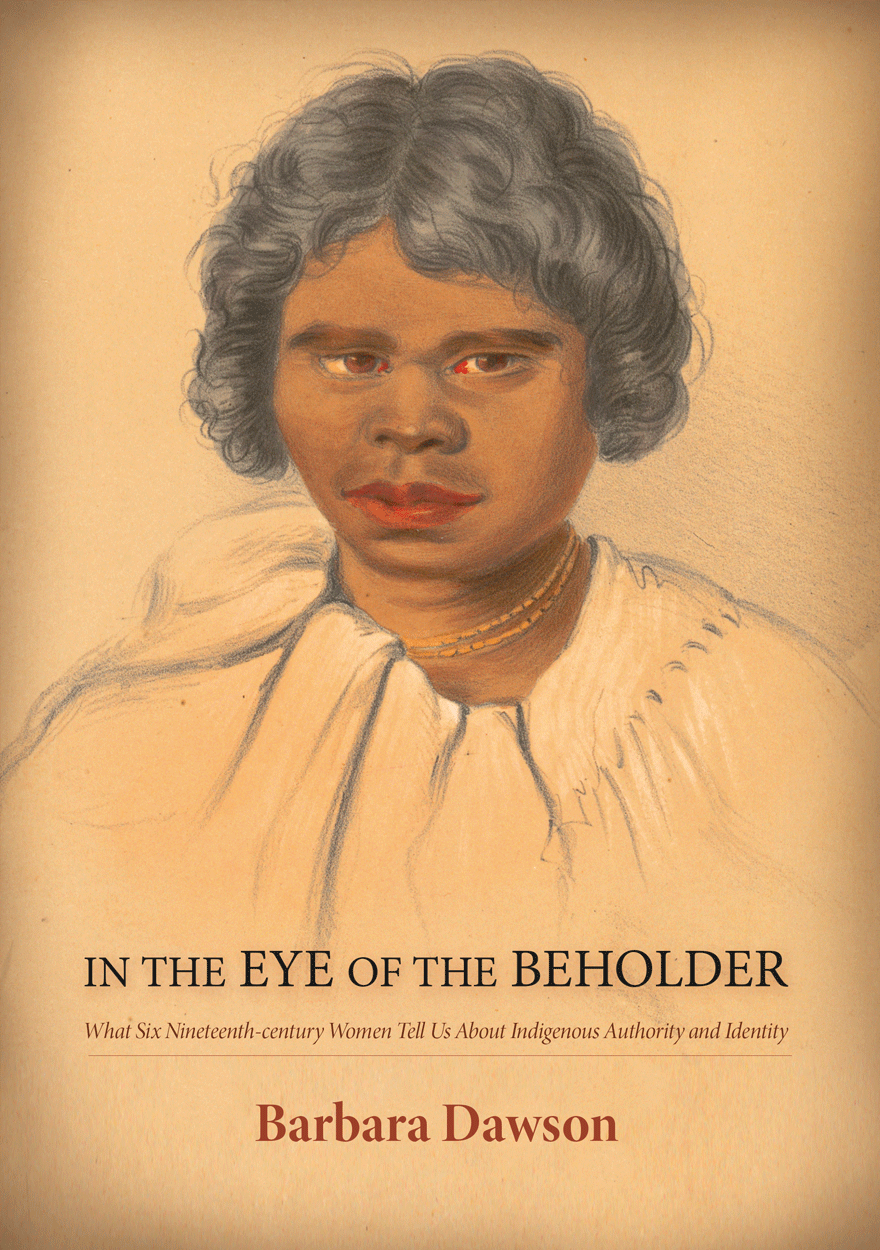Search titles
Displaying results 221 to 230 of 558.

Settler Colonial Governance in Nineteenth-Century Victoria »
Edited by: Leigh Boucher, Lynette Russell
Publication date: April 2015
This collection represents a serious re-examination of existing work on the Aboriginal history of nineteenth-century Victoria, deploying the insights of postcolonial thought to wrench open the inner workings of territorial expropriation and its historically tenacious variability. Colonial historians have frequently asserted that the management and control of Aboriginal people in colonial Victoria was historically exceptional; by the end of the century, colonies across mainland Australia looked to Victoria as a ‘model’ for how to manage the problem of Aboriginal survival. This collection carefully traces the emergence and enactment of this ‘model’ in the years after colonial separation, the idiosyncrasies of its application and the impact it had on Aboriginal lives.
It is no exaggeration to say that the work on colonial Victoria represented here is in the vanguard of what we might see as a ‘new Australian colonial history’. This is a quite distinctive development shaped by the aftermath of the history wars within Australia and through engagement with the ‘new imperial history’ of Britain and its empire. It is characterised by an awareness of colonial Australia’s positioning within broader imperial circuits through which key personnel, ideas and practices flowed, and also by ‘local’ settler society’s impact upon, and entanglements with, Aboriginal Australia. The volume heralds a new, spatially aware, movement within Australian history writing. – Alan Lester
This is a timely, astutely assembled and well nuanced collection that combines theoretical sophistication with empirical solidity. Theoretically, it engages knowledgeably but not uncritically with a broad range of influences, including postcolonialism, the new imperial history, settler colonial studies and critical Indigenous studies. Empirically, contributors have trawled an impressive array of archival sources, both standard and relatively unknown, bringing a fresh eye to bear on what we thought we knew but would now benefit from reconsidering. Though the collection wears its politics openly, it does so lightly and without jeopardising fidelity to its sources. – Patrick Wolfe
For more information on Aboriginal History Inc. please visit aboriginalhistory.org.au.

Innamincka Talk: A grammar of the Innamincka dialect of Yandruwandha with notes on other dialects »
Authored by: Gavan Breen
Publication date: April 2015
Innamincka Talk: A grammar of the Innamincka dialect of Yandruwandha with notes on other dialects is one of a pair of companion volumes on Yandruwandha, a dialect of the language formerly spoken on the Cooper and Strzelecki Creeks and the country to the north of the Cooper, in the northeast corner of South Australia and a neighbouring strip of Queensland. The other volume is entitledInnamincka Words.
Innamincka Talk is the more technical work of the two and is intended for specialists and for interested readers who are willing to put some time and effort into studying the language.Innamincka Words is for readers, especially descendants of the original people of the area, who are interested in the language, but not necessarily interested in its more technical aspects. It is also a necessary resource for users of Innamincka Talk.
These volumes document all that could be learnt from the last speakers of the language in the last years of their lives by a linguist who was involved with other languages at the same time. These were people who did not have a full knowledge of the culture of their forebears, but were highly competent, indeed brilliant, in the way they could teach what they knew to the linguist student.

Innamincka Words: Yandruwandha dictionary and stories »
Edited by: Gavan Breen
Publication date: April 2015
Innamincka Words: Yandruwandha dictionary and stories is one of a pair of companion volumes on Yandruwandha, a dialect of the language formerly spoken on the Cooper and Strzelecki Creeks and the country to the north of the Cooper, in the northeast corner of South Australia and a neighbouring strip of Queensland. The other volume is entitled Innamincka Talk: a grammar of the Innamincka dialect of Yandruwandha with notes on other dialects. Innamincka Words is for readers, especially descendants of the
original people of the area, who are interested in the language. It is also a necessary resource for users of the more technical Innamincka Talk.
These volumes document all that could be learnt from the last speakers of the language in the last years of their lives by a linguist who was involved with other languages at the same time. These were people who did not have a full knowledge of the culture of their forebears, but were highly competent, indeed brilliant, in the way they could teach what they knew to the linguist student.

Aboriginal History Journal: Volume 38 »
Edited by: Shino Konishi
Publication date: January 2015
Volume 38 features a special section on Western Australian Aboriginal history. Clint Bracknell translates and contextualises nineteenth-century Noongar songs. Amanda Nettelbeck considers the role of magistrates and justices of the peace in the ‘frontier legal networks’ of the Pilbara and Kimberley regions. Anne Scrimgeour traces the changing approach to the administration of Aboriginal people in the twentieth-century north-west through the biography of Laurie O’Neill, a former mounted policeman and travelling inspector. Craig Muller studies the history of the Wongatha of the north-east part of the Goldfields. Muller finds that Elkin’s account of his brief 1930 visit to the region was used as evidence in the recent Wongatha native title case without sufficient historical contextualisation. Together, the papers draw on rich archival sources, complicate our understandings of the way in which Aboriginal lives were controlled in the past, and highlight Aboriginal voices and perspectives.
The other four articles exploring Aboriginal histories from other parts of Australia. Nicholas Brodie reconstructs the life of Dalrymple Briggs, a Vandemonian woman of mixed-descent. Noah Riseman examines the lives of three Aboriginal servicemen who all had media profiles as successful examples of assimilation. The other two articles examine different non-Indigenous accounts of Aboriginal people and culture. Marguerita Stephens critically examines discourses on Aboriginal infanticide in colonial Victoria. The history of tourist visits to Palm Island, an Aboriginal reserve in Queensland is the focus of Toby Martin’s article.
Aboriginal History Inc. is a publishing organisation based in the Australian Centre for Indigenous History, Research School of Social Sciences, The Australian National University, Canberra.
For more information on Aboriginal History Inc. please visit aboriginalhistory.org.au.
Download for free
Not available for purchase

Abbott's Gambit »
The 2013 Australian Federal Election
Publication date: January 2015
This book provides a truly comprehensive analysis of the 2013 federal election in Australia, which brought the conservative Abbott government to power, consigned the fractious Labor Party to the Opposition benches and ended the ‘hung parliament’ experiment of 2010–13 in which the Greens and three independents lent their support to form a minority Labor government. It charts the dynamics of this significant election and the twists and turns of the campaign itself against a backdrop of a very tumultuous period in Australian politics. Like the earlier federal election of 2010, the election of 2013 was an exercise in bipolar adversarial politics and was bitterly fought by the main protagonists. It was also characterised (again) by leadership changes on Labor’s side as well as the entry of new political parties anxious to deny the major parties a clear mandate. Moreover, the 2013 election continued the trend whereby an increasing proportion of the electorate chose not to vote for one of the main two political parties.
While the 2013 election delivered a clear victory to the Coalition in the Lower House, it simultaneously produced a much more mixed outcome in the Senate, where the Greens managed to record their largest ever representation and a new party, the Palmer United Party, initially secured three Senate positions at its first attempt (together with the election of Clive Palmer to a Queensland seat in the House of Representatives). With minor and micro parties also winning Senate seats amounting to a total of 18 Senators on the cross-benches, the Abbott government’s ability to govern and pass legislation was placed in some doubt. The 2013 election result suggested that far from ending the preceding tumultuous period of Australian politics, it merely served to prolong this era indefinitely.
The 2013 campaign was one of the longest on record, arguably commencing when the besieged Prime Minister Julia Gillard announced the date for the election in late January 2013 – then over seven months away. This unconventional tactic overshadowed the election from that date onwards – providing a definite timeline for Labor infighting, influencing the largely negative tactics of the Opposition, and encouraging new parties to proliferate to contest the election. This volume traces these formative influences on the campaign dynamics and explains the electoral outcome that occurred (including the 2014 re-election for the Western Australian Senate seats ordered by the High Court). Abbott’s Gambit includes insightful contributions from academic experts, campaign directors and electoral watchers, political advisers and professional psephologists. Contributors utilise a wide range of sources and approaches, including the Australian Election Survey, to provide a detailed analysis of this important federal election.

Circulating Cultures »
Exchanges of Australian Indigenous Music, Dance and Media
Edited by: Amanda Harris
Publication date: December 2014
Circulating Cultures is an edited book about the transformation of cultural materials through the Australian landscape. The book explores cultural circulation, exchange and transit, through events such as the geographical movement of song series across the Kimberley and Arnhem Land; the transformation of Australian Aboriginal dance in the hands of an American choreographer; and the indigenisation of symbolic meanings in heavy metal music. Circulating Cultures crosses disciplinary boundaries, with contributions from historians, musicologists, linguists and dance historians, to depict shifts of cultural materials through time, place and interventions from people. It looks at the way Indigenous and non-Indigenous performing arts have changed through intercultural influence and collaboration.

Global Warming and Climate Change »
What Australia knew and buried...then framed a new reality for the public
Authored by: Maria Taylor
Publication date: December 2014
1988: coming to grips with a terrifying global experiment
The Toronto conference statement made it clear that climate change would affect everyone. It called greenhouse gas atmospheric pollution an ‘uncontrolled, globally pervasive experiment whose ultimate consequences could be second only to nuclear war’. World governments were urged to swiftly develop emission reduction targets (The changing atmosphere: implications for global security, 1988).
Relevant to both Australian and overseas audiences, here is the untold story of how Australia buried its knowledge on climate change science and response options during the 1990s — going from clarity to confusion and doubt after arguably leading the world in citizen understanding and a political will to act in the late 1980s. ‘What happened and why’ is a fascinating exploration drawing on the public record of how a society revised its good understanding on a critical issue affecting every citizen. It happened through political and media communication, regardless of international scientific assessments that have remained consistent in ascribing causes and risks since 1990. How could this happen? The author examines the major influences, with lessons for the present, on how the story was reframed. Key have been values and beliefs, including economic beliefs, that trumped the science, the ability of changing political leaders and the mass media to set the story for the public, as well as the role of scientists’ own communication over time and the use and misuse of uncertainty.
For more information on this publication, plus book reviews, please see Maria Taylor’s author website.

Law and Democracy »
Contemporary Questions
Edited by: Glenn Patmore, Kim Rubenstein
Publication date: December 2014
Law and Democracy: Contemporary Questions provides a fresh understanding of law’s regulation of Australian democracy. The book enriches public law scholarship, deepening and challenging the current conceptions of law’s regulation of popular participation and legal representation. The book raises and addresses a number of contemporary questions about legal institutions, principles and practices:
How should the meaning of ‘the people’ in the Australian Constitution be defined by the High Court of Australia?
How do developing judicial conceptions of democracy define citizenship?
What is the legal right to participate in the political community?
Should political advisors to Ministers be subject to legal accountability mechanisms?
What challenges do applied law schemes pose to notions of responsible government and how can they be best addressed?
How can the study of the ritual of electoral politics in Australia and other common law countries supplement the standard account of democracy?
How might the ritual of the pledge of Australian citizenship limit or enhance democratic participation?
What is the conflict between legal restrictions of freedom of expression and democracy, and the role of social media?
Examining the regulation of democracy, this book scrutinises the assumptions and scope of constitutional democracy and enhances our understanding of the frontiers of accountability and responsible government. In addition, key issues of law, culture and democracy are revealed in their socio-legal context.
The book brings together emerging and established scholars and practitioners with expertise in public law. It will be of interest to those studying law, politics, cultural studies and contemporary history.

Diversity in Leadership »
Australian women, past and present
Edited by: Joy Damousi, Kim Rubenstein, Mary Tomsic
Publication date: November 2014
While leadership is an over-used term today, how it is defined for women and the contexts in which it emerges remains elusive. Moreover, women are exhorted to exercise leadership, but occupying leadership positions has its challenges. Issues of access, acceptable behaviour and the development of skills to be successful leaders are just some of them.
Diversity in Leadership: Australian women, past and present provides a new understanding of the historical and contemporary aspects of Indigenous and non-Indigenous women’s leadership in a range of local, national and international contexts. It brings interdisciplinary expertise to the topic from leading scholars in a range of fields and diverse backgrounds. The aims of the essays in the collection document the extent and diverse nature of women’s social and political leadership across various pursuits and endeavours within democratic political structures.

In the Eye of the Beholder »
What Six Nineteenth-century Women Tell Us About Indigenous Authority and Identity
Authored by: Barbara Dawson
Publication date: November 2014
This book offers a fresh perspective in the debate on settler perceptions of Indigenous Australians. It draws together a suite of little known colonial women (apart from Eliza Fraser) and investigates their writings for what they reveal about their attitudes to, views on and beliefs about Aboriginal people, as presented in their published works. The way that reader expectations and publishers’ requirements slanted their representations forms part of this analysis.
All six women write of their first-hand experiences on Australian frontiers of settlement. The division into ‘adventurers’ (Eliza Fraser, Eliza Davies and Emily Cowl) and longer-term ‘settlers’ (Katherine Kirkland, Mary McConnel and Rose Scott Cowen) allows interrogation into the differing representations between those with a transitory knowledge of Indigenous people and those who had a close and more permanent relationship with Indigenous women, even encompassing individual friendship. More pertinently, the book strives to reveal the aspects, largely overlooked in colonial narratives, of Indigenous agency, authority and individuality.
For more information on Aboriginal History Inc. please visit aboriginalhistory.org.au.



